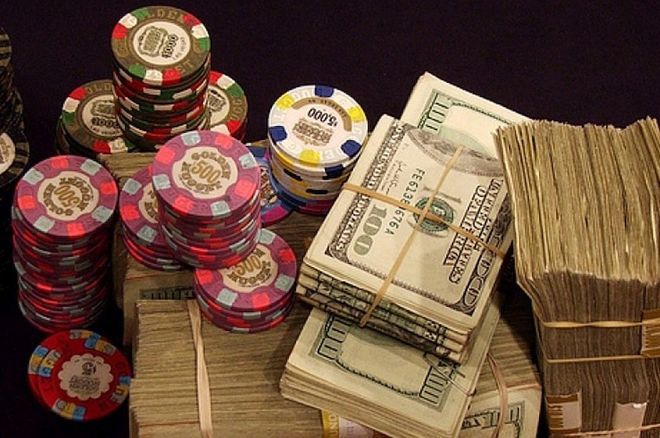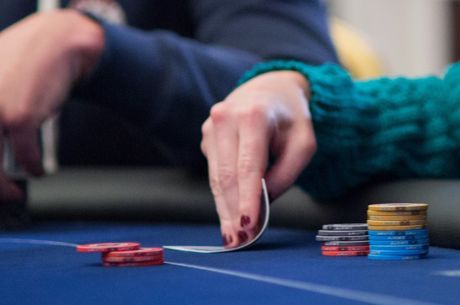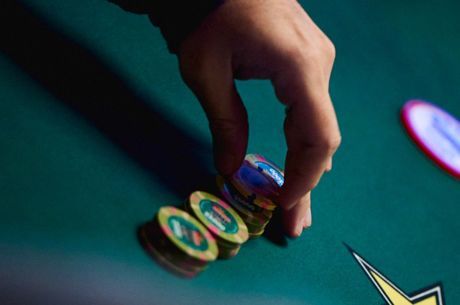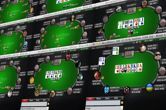His and Hers Poker: The Goal of Poker

Greetings, Poker Friends! We start off this article with something of a philosophical question: "What is the goal of poker?" Let's see if we can find the answer as we examine this week's hand.
The Table and Villain(s)
Hero (Tracey) is at a $2/$5 table at the Borgata in the early morning. The main Villain is in the small blind, a recreational player in his late 40s. Villain is relatively new to the table, but Hero has already picked up enough to know that he is playing a fairly generic loose-passive game. He has not donk led any flops thus far.
Effective Stacks: ~$425 (Villain).
Preflop
Action
Hero is under the gun and opens to $25 with J?J?. It folds all the way around to the Villain, who is the only caller from the small blind.
Analysis
Here, Tracey uses a slightly larger opening sizing from early position in an attempt to isolate down to a reasonable number of callers. J?J? is certainly a strong starting hand, but it is not one that is going to play particularly well postflop when out of position to a ton of callers. If you are at a table where you think you can generate some more folds by opening for a larger bet sizing from early position, it can be a good experiment to try out.
Flop
Action
We go heads-up to the flop with $55 in the pot. The flop is 8?4?3?. Villain is first to act from the small blind and he donk leads for $35. Hero calls.
Analysis
The most frustrating part about a donk lead is interpreting it. These leads can be incredibly player dependent. Some people donk lead whenever they hit top pair. Others check top pair, but donk lead if they hit middle or bottom pair. Still others check all of their pairs, but donk lead when they flop a strong combo draw. The list goes on and on, and if you've played for long enough you've probably seen it all.
How do we interpret a donk lead from a relative newcomer? As with many things in poker, we will have to rely on probabilities.
On such a dry board, a strong drawing hand seems very unlikely. That means he likely has a made hand which he feels is strong enough to bet. How strong? That is the most difficult question to answer. Most players will only donk lead with one-pair hands. If they have something better than one pair, their greed leads them not to risk pushing out their opponents. That being said, we have seen players donk lead with the absolute nuts.
Once again, we are left to speak in probabilities. The most probable holding for Villain here is a one-pair hand.
Now, how do we want to respond? If we raise on such a dry board, we will telegraph our holding and risk only getting called on the rare occasions when Villain has something that has us beat. Better to call and to let Villain continue to overvalue his one-pair hands than raise and possibly walk into a buzz saw.
Turn
Action
With $125 in the pot, the turn brings the J? for a turn board of 8?4?3?J?. Villain bets $80. Hero calls.
Analysis
When we turn the nuts, all thoughts of accidentally walking into a monster obviously go right out the window. Now we just have to think about how to maximize value.
Our opponent's reaction to the J? tells us a ton about his holding. Many passive players who donk lead the flop with a low, single pair will check the turn when an overcard comes. Villain's bet of nearly two-thirds the pot on this turn means that we have very likely run into the rare opponent who donk led the flop with something better than one pair.
When he does lead again here, do we want to raise or call in response? The two of us got into a lively discussion about this topic when first examining this hand. Initially, Tracey said she called because she did not want to tip off the Villain to the fact that she had the nuts and possibly risk making him fold. This prompted Matt to ask the question with which we started off this article: "What is the goal of poker?" For the serious player, the answer is "to make money."
Many low-stakes players play like the answer to this question is rather "to deceive my opponents." To see this in action, you only need to watch how often low-stakes players slow play the nuts. Seemingly, they would rather win a small pot in a tricky fashion than win a bigger pot in an obvious fashion. They feel the worst crime they can commit is to tip off their hand to their opponent. In reality, the worst "poker crime" that you can commit is not to make the maximum amount of money.
Tracey's objection to raising here was better formed. "I'd raise on a wetter board, but I can't represent any draws here," she said, "So he's going to know I have a monster."
That's quite true. If we raise here, our opponent will know we have a very good hand. If our goal was deception, then, raising would be a terrible idea. But our goal is not deception �� it is making money. Specifically, our goal is stacking our opponent. Let's look at the competing lines and figure out which one will, on average, allow us to do that more often.
Our first option is to call the turn. That will give us a river pot of $285 and Villain will have $285 remaining.
Some percentage of the time, Villain will keep betting. In that event, we will shove and will get a call on most occasions. Some percentage of the time, the Villain will wake up on the river and realize that Hero has a really good hand, just by virtue of having called two streets. Some other percentage of the time, the river will be a card which scares Villain into thinking his holding might not be good any more.
In either of these second two events, Villain will check. We can then put out a small bet and try to get Villain to call out of pure curiosity. Or, we can try for the long pass and shove for a pot-sized bet.
Our second option is to raise the turn to around $180.
Some percentage of the time, Villain will fold to our raise. More often, Villain will refuse to lay down to a 2.25x raise with a hand that he liked enough to bet two-thirds pot. If Villain calls, the river pot will be $485 and Villain will have $185 remaining. We will then shove after he checks. Sometimes, Villain will fold. However, it is highly likely that a large percentage of the time, Villain will call off for what is around a 40 percent pot-sized bet.
From this analysis, we can see that there are two possibilities that we are really putting in the scales when we ask the question of how we are going to stack our opponent. In one half of the scale, we put the probability that Villain will call a 2.25x raise on the turn and then a 40 percent pot-sized bet on the river. In the other side of the scale, we put the combined probabilities that (1) Villain will keep betting the river and then call off to a shove, or (2) that he will check the river and then call a pot-sized shove.
Which way do you feel the scale tips? After review, our answer is to make a small raise to set up a river shove.
River
Action
With $285 in the pot, the river is the A?. That makes the final board 8?4?3?J?A?. Villain checks. Hero shoves for $285. Villain tanks for several minutes before finally folding.
Analysis
When Villain tanks for this long on the river, we can know with near certainty that he had a holding like 4x3x that he was never folding on the turn to a $180 raise and that he would then have called off with on the river for the remainder of his $185 stack. There was definitely value missed here.
The Takeaway
Structure your bets and raises to get stacks in by the river when you have a monster value hand, even if it tips off your opponent as to your holding. Your goal is to make maximum value, not to be deceptive.
His and Hers Poker is a free, weekly strategy podcast hosted by Matt and Tracey Waldt. They are a married couple who play live cash games on the East Coast. Their podcast focuses on providing practical advice about hand reading, with an emphasis on how to identify and exploit the common leaks and imbalances of low-stakes players. His and Hers Poker can be found on iTunes, Google Play and other podcast services. For more information, and to subscribe, please visit hisandherspoker.com.









